Kingdom Animalia Order Chiroptera Subfamily Myotinae Scientific name Myotis lucifugus Rank Species | Phylum Chordata Family Vespertilionidae Genus Myotis Higher classification Mouse-eared bat | |
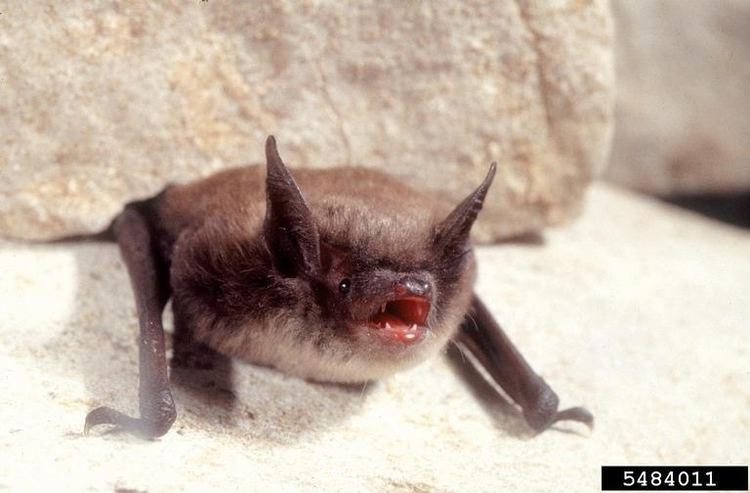 | ||
Similar Bat, Big brown bat, Mouse‑eared bat, Eptesicus, Mammal | ||
Little brown bat stretches and yawns before taking a nap
The little brown bat (sometimes called little brown myotis) (Myotis lucifugus) is a species of the genus Myotis (mouse-eared bats), one of the most common bats of North America. The little brown bat has been a model organism for studying bats.
Contents
- Little brown bat stretches and yawns before taking a nap
- Little brown bat 60 seconds
- Description
- Range and ecology
- Habitat and roosting
- Diet
- Mortality
- Sleep
- Behavior
- Echolocation and communication
- Mating and reproduction
- Genome projects
- References
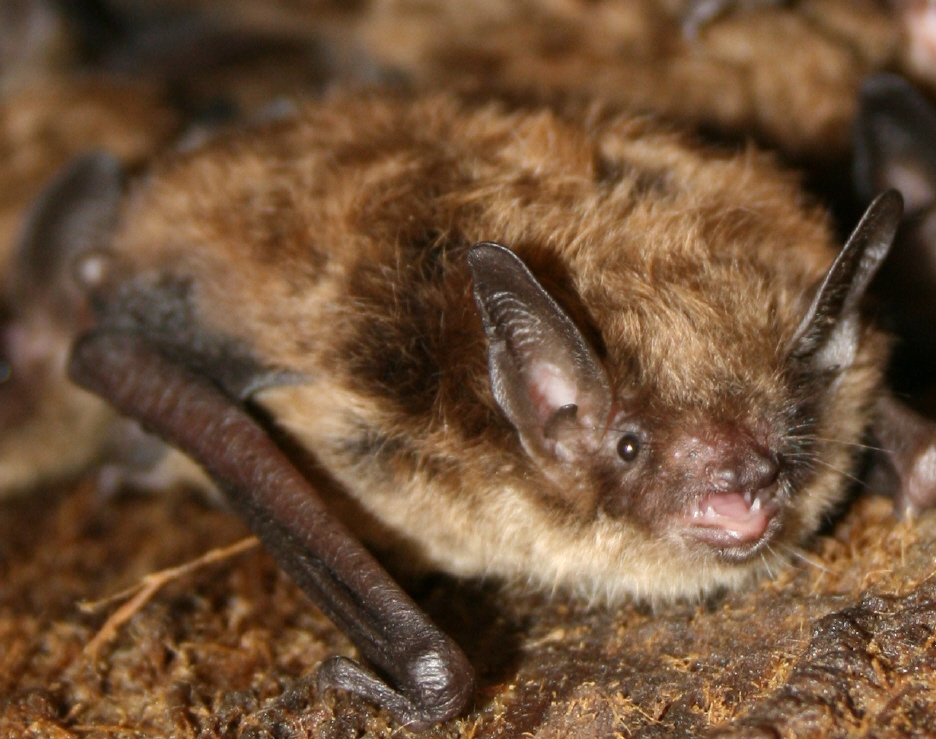
Little brown bat 60 seconds
Description
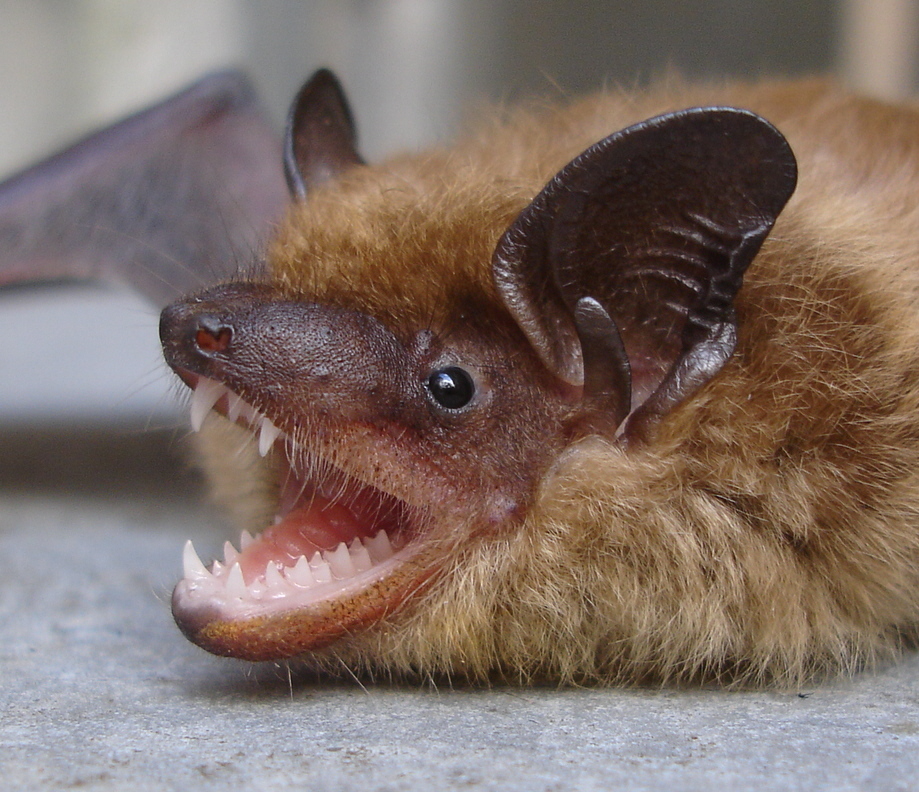
As suggested by the bat’s name, its fur is uniformly dark brown and glossy on the back and upper parts with slightly paler, greyish fur underneath. Wing membranes are dark brown on a typical wingspan of 22–27 cm (8.7–10.6 in). Ears are small and black with a short, rounded tragus. Adult bats are typically 6–10 cm (2.4–3.9 in) long and weigh 5–14 grams (0.2–0.5 oz). Females tend to be larger than males. The fore and hind limbs have five metapodials. The skull of the brown bat lacks a sagittal crest. Its rostrum is shortened and has upslope profile of the forehead. Its braincase flattened and sub-circular when observed dorsally. The bat has 38 teeth all of which including molars are relatively sharp, as is typical for an insectivore, and canines are prominent to enable grasping hard-bodied insects in flight.

The little brown bat can be distinguished from the Indiana bat by the absence of a keel on the caclar and long hairs on the hind feet that stretch longer than the toes. Compared to the long-legged bat, the brown bat has a shorter tibia and lesser amounts of ventral wing hair in addition to the lack of a keel on the caclar.
Range and ecology
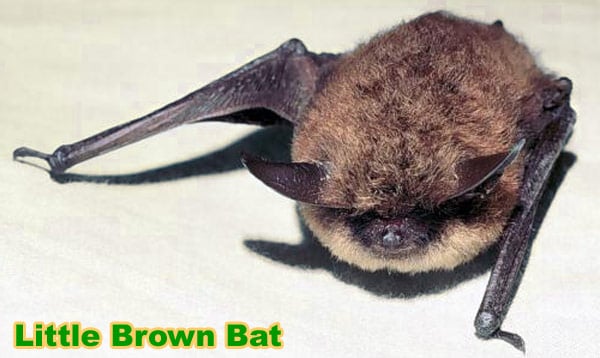
The little brown bat is found throughout much of North America. It is most common in the northern half of the continental United States and southern Canada. Most specimens from the northern edge of its range are males although nursery roosts have been found in the Yukon. Brown bats have been found in Iceland, Alaska, and Kamchatka, likely due to accidental ship transportation by humans.
Habitat and roosting
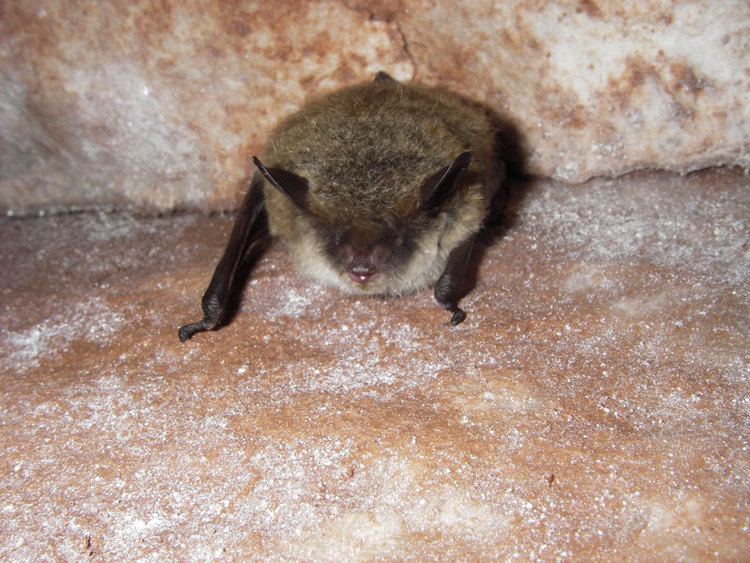
The little brown bat lives in three different roosting sites: day roosts, night roost and hibernation roosts. Bats use day and night roosts during spring, summer, and fall while hibernacula are used in winter. Day roosts are usually found in buildings or trees, under rocks or wood piles and sometimes in caves. Nursery roosts are found in both natural hollows and in buildings (or at least close to them). Nursery roosts have also been found under the sheet metal roofs of trappers' caches and attics of buildings. Night roosts tend to be in the same buildings as day roosts, but these roosts tend to be in different spots that are more constrained and the bats pack together for warmth. Bats rest in night roosts after feeding in the evening which may serve to keep their feces away from the day roosts and thus less noticeable to predators. Brown bats typically hibernate in caves and perhaps unused mines. Northern populations of bats enter hibernation in early September and end in mid-May while southern populations enter in November and ends mid-March. Little brown bats are not true hibernators. As observed in the Mid-Atlantic States during periods of warming during the winter, typically over 50 degrees (F), little brown bats emerge from their winter torpor and hunt insects that have emerged as well in response to the warmer conditions.
Diet

Little brown bats are insectivores, eating moths, wasps, beetles, gnats, mosquitoes, midges and mayflies, among others. Since many of their preferred meals are insects with an aquatic life stage, such as mosquitoes, they prefer to roost near water. Brown bats forage near bodies of water and move in and out of adjacent vegetation. Evening forages are done in groups and above the water. They echolocate to find their prey. They are particularly good at hunting insects when they are at close range and packed together. When hunting, little brown bats capture prey both by gleaning and by catching them in the air. When in flight, bats scoop up the prey with their wings, while prey above water is directly grabbed with the mouth.
Brown bats do not claim feeding areas like a territory, however individuals frequently return to the same feeding sites where they have previously made successful catches. When hunting swarms, brown bats usually select no more than two species. They feed on more species when they are scattered. If they do not catch any food, they will enter a torpor similar to hibernation that day, awakening at night to hunt again.
The bats' diet makes this species beneficial to agriculture as it eats many species of agricultural pests.
Mortality
Brown bats live approximately 6 to 7 years and often live well beyond 10 years. Little brown bats are preyed on by a variety of animals, including small carnivores, birds, rats and snakes. Many predators target bats when they are packed together in roosts. Martens and fishers will snatch young or hibernating individuals that have fallen to the ground. Brown bats are also hosts for various parasites such as fleas, bat bugs and lice. Bats are killed by accidents more often than predators or parasites. They can get impaled on barbed wire and burdocks or drown in floods during hibernation. Pesticides can also kill them. However DDT has little effect on the bats. They also seem to have low levels of rabies.
Little brown bats are now at a higher threat due to white nose syndrome (WNS) in eastern North America. White nose syndrome is caused by the fungus, Pseudogymnoascus destructans, which affects bats during hibernation. " WNS is estimated to have killed more than 5.5 million bats in the Northeast and Canada. In some sites, 90 to 100 percent of bats have died (U.S. Fish and Wildlife Services, 2015)." Many states have made special considerations with respect to the disease, including listing them as a sensitive or protected species. Canada has listed them as an endangered species. It is estimated that 94% of the population in the eastern half of the country has died over the last few years from WNS, and the disease is moving westward at a rate that may see them extirpated within as little as 12 years. It is expected that the tri-colored bat will also be listed in a few years due to WNS, and the northern long-eared bat was recently federally listed as threatened due to WNS.
Sleep
In the wild, little brown bats can be very active during the day in the spring months, where they can be heard loudly squeaking, shuffling position and seen hanging out the bottom of the bat house during all hours of the daytime. The average sleep time of a little brown bat in captivity is said to be 19.9 hours per day. This long period of sleep is thought to be a way of conserving energy, by only hunting for a few hours each night when their insect prey are available.
Behavior
As with most bats, the little brown bat is mostly active at night and leaves its roost at dusk and the next two or three hours are peak activity periods. They are also active before dawn. Since little brown bats live in a temperate zone, they must find some way of dealing with winter. Most temperate bats either migrate or hibernate, but little brown bats do both. In summer, the males and females live apart, the females raise the young. When fall comes, both sexes fly south to a hibernaculum, where they mate and then hibernate. Little brown bats undergo a prolonged period of hibernation during the winter due to the lack of food. They hibernate in caves as a community.
Echolocation and communication
Little brown bats produce calls that are high intensity frequency modulated (FM) and that last from less than one millisecond (ms) to about 5 ms and have a sweep rate of 80–40 kHz, with most of their energy at 45 kHz. Bats usually emit 20 calls per second when in flight. When pursuing prey, a bat emits 200 calls per second. It also emits a high-pulse repetitive call if it wants to land.
Bats that are in danger of colliding will reduce the terminal portion of their sweep calls to 25 kHz, creating a "honking" sound. The bats also find roosting sites by listening to the echolocation calls of other individuals. Some complex vocalizations are used by mothers and their pups.
Mating and reproduction
Brown bat mating occurs in two phases, active and passive. In the active phase, both partners are awake and alert. In the passive state, active males try to mate with torpid bats regardless of their sex. Active phase matings are more common as there are peaks in testosterone. There is some conflicting reports on whether active females store sperm. Active mating is at its highest in August but passive mating lasts until winter. During mating, the male mounts the female from the rear and may use a copulation call to calm her so she won't struggle. Bats mate promiscuously. Neither sex is selective of their mates and males can't monopolize females when torpid.
When they arise in the spring, the females go to nursery colonies which may often be the same place where they were born. These nursery colonies consist mainly of adult females and their young and can be located in the attics of warm buildings where there is high humidity. These colonies sometimes reach numbers of bats as great as 1,000 per cave/forest. Gestation lasts 50–60 days. They usually have one baby per female each year, sometimes twins, born sometime from late May to early July. The young are born in an altricial state with their eyes closed and will hang in the nursery while their mothers forage at night. Their eyes open on their second day. They cling to a nipple constantly until they are two weeks old. At three weeks, they learn to fly. By four weeks, they are adult sized. Females may be sexually mature in the fall after their birth, but males may take a year longer. About half of females and most males breed during their first autumn.
Genome projects
The genome of M. lucifugus has been sequenced at 7x coverage for the Mammalian Genome Project. The full sequence and annotation is available on the Ensembl Genome Browser. This species is also part of the ENCODE comparative sequencing project.
